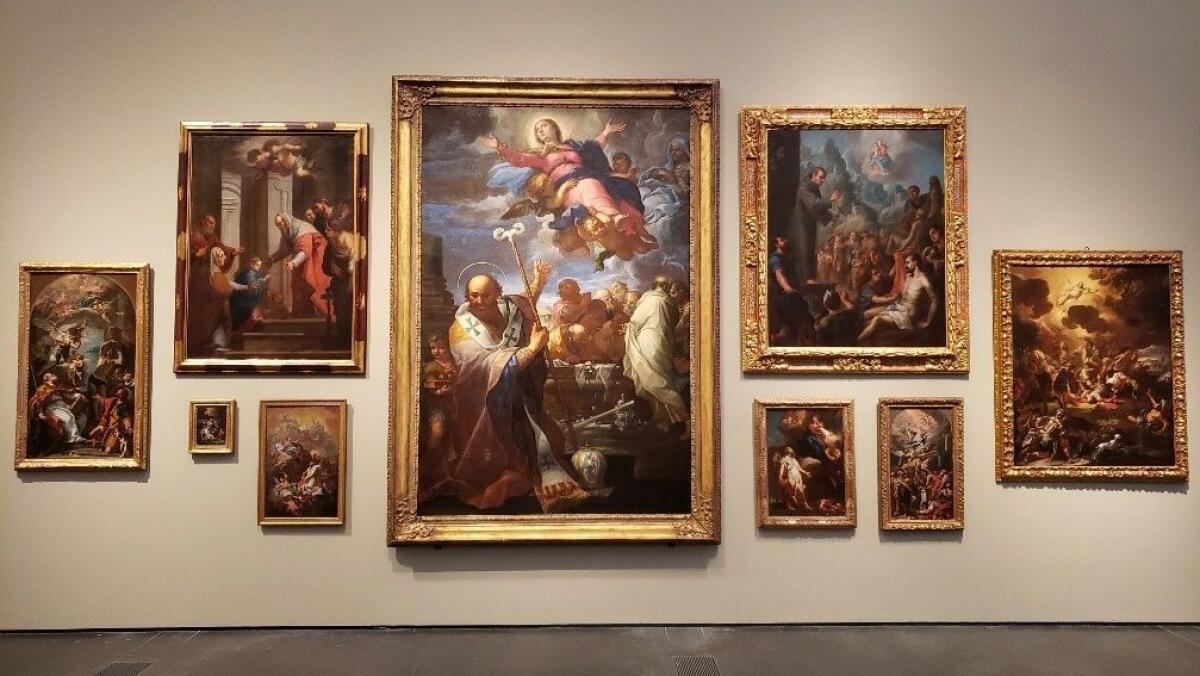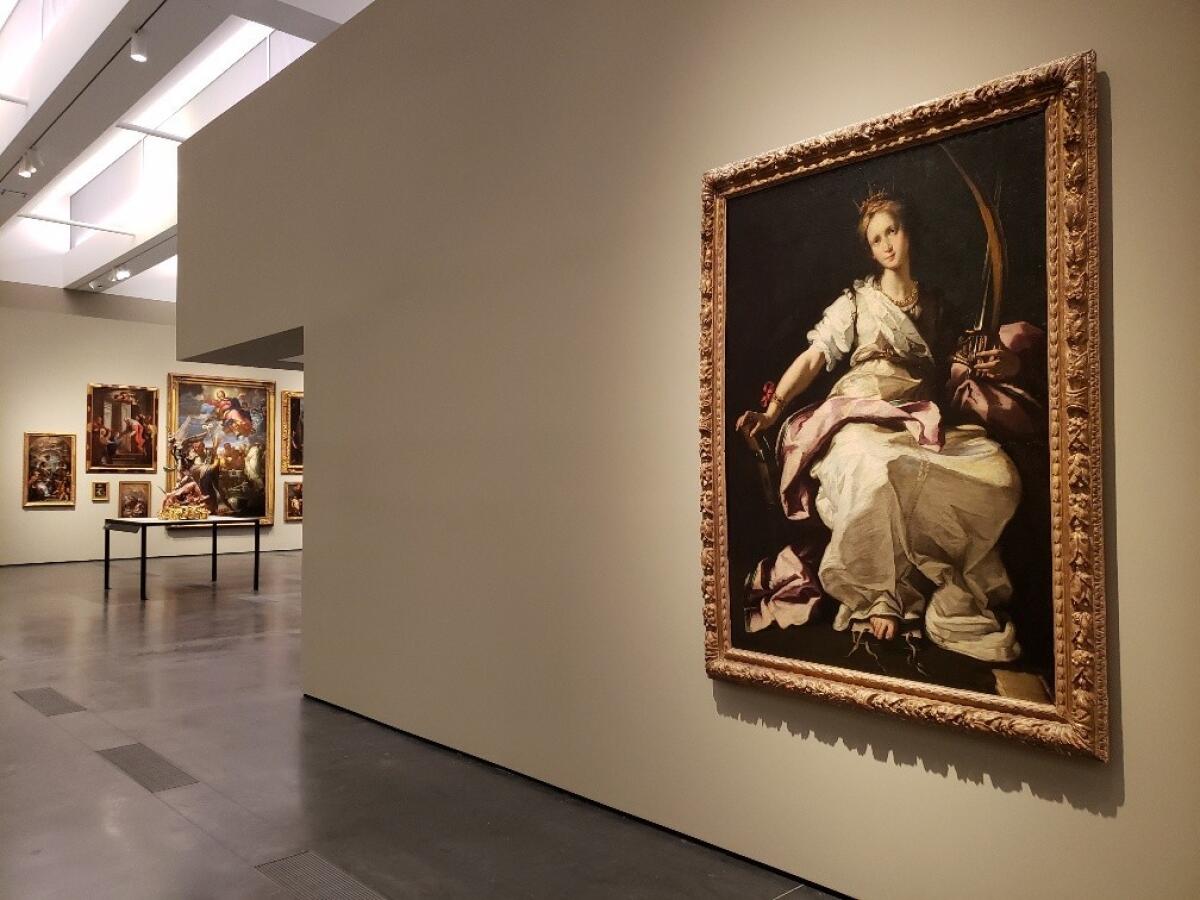Critic’s Notebook: Troublesome signs in LACMA’s risky reorganization plan

Without fanfare, the Los Angeles County Museum of Art has taken a momentous step. Separate curatorial divisions for American art and for European painting and sculpture, established when the museum opened its Wilshire Boulevard doors more than half a century ago, are now united under a single department head.
Sound bizarre? It is. No other museum of LACMA’s size and complexity does it.
LACMA’s European collections include Continental and British art produced from the Middle Ages to the end of the 19th century, while its American holdings continue to the start of World War II. Two big museum departments have essentially collapsed into one.
Fitz Henry Lane’s icily crisp view of majestic schooners, stilled in the setting sun of 1850s Boston Harbor, is under the same curatorial umbrella as a painting of the goddess Venus disarming little Cupid by Alessandro Allori, the prolific 16th century Florentine Mannerist.
A 15th century German woodcarving of the Virgin and child standing on a crescent moon, described in an apocalyptic vision by the enigmatic St. John, will henceforth curatorially cohabit with Guy Pène du Bois’ painted scene of two Roaring ’20s flappers who have stopped in front of a New York City shop so one can adjust her stocking.
The strange mash-up is in fact the first concrete step in Director Michael Govan’s plan to create a non-departmental art museum, for which Swiss architect Peter Zumthor is designing a controversial new building. (The project website is at buildinglacma.org.) The idea is to show LACMA’s diverse art collections as changing, cross-cultural theme exhibitions, rather than as relatively permanent displays organized by department.
Originally skeptical of the plan, I’m less confident than ever. That’s because of an unsuccessful sample of what’s to come.
‚ÄúTo Rome and Back: Individualism and Authority in Art, 1500-1800‚ÄĚ has been on view since June in the Resnick Pavilion. (It closes March 17.) The theme is the pull of the Eternal City on the artistic imagination from the Renaissance to the European Enlightenment, when Rome‚Äôs influence largely evaporated.
But the show is bland and ineffectual. About 130 objects are on view, drawn from LACMA’s collections of European painting and sculpture, decorative arts, prints and drawings, Latin American art, costumes and textiles.
REVIEW: Review: Charles White show pinpoints the power of an underappreciated black artist ¬Ľ
A few loans are here too, including a newly rediscovered, rather ungainly painting of Cleopatra, circa 1630, by Artemisia Gentileschi, borrowed from a local private collection. Better would have been a loan from the Getty Museum of ‚ÄúModern Rome,‚ÄĚ J.M.W. Turner‚Äôs dreamily iridescent 1839 masterpiece and European art‚Äôs definitive take on the city‚Äôs vaporous dissolution.
The installation is organized into seven chapters.
‚ÄúMeanings of Rome‚ÄĚ considers the city as both a real place with an ancient history and a fantasized product of literary imagination. ‚ÄúInspiration and Awe‚ÄĚ tackles theatricality, courtesy of the Vatican‚Äôs demand for spectacle. A section on ‚ÄúClassical Authority‚ÄĚ might be retitled ‚ÄúWe‚Äôre Rome, and You‚Äôre Not.‚ÄĚ Etc.
If you think LACMA has the holdings to illuminate these sweeping themes in significant ways, you would be wrong. To be sure, wonderful objects are on view. But this mixed-up jumble of stuff skids along the topical surface. Connections with Rome are often flimsy, stretched to a breaking point.
Just because a ‚ÄúHoly Family‚ÄĚ is dressed in robes and the Virgin stands in a hip-thrust pose with some classical buildings in the background doesn‚Äôt tell us anything meaningful about art in Florence, where 25-year-old Fra Bartolommeo painted the picture, or about Roman influence during contemporaneous political upheaval in Tuscany. Classicism had also been a feature of medieval art, while the artist, not yet even a monk, wouldn‚Äôt travel to Rome until he was in his 40s.
At the other end of the spectrum, no wall text identifies the enthroned figure of St. Catherine painted by Bernardo Strozzi, who worked mostly in Genoa and Venice, as a direct reference to pagan oracles in Michelangelo’s Sistine Chapel ceiling. If you didn’t already know it when you arrived at the show, you wouldn’t know when you left either.

Yes, Bolivia and Ecuador were Spanish Catholic outposts in South America; but in the painting by colonial artist Antonio Mont√ļfar, do we really discover anything of substance about Rome just because Pope Nicholas V is having a vision of St. Francis? One of seven figures in Spanish painter Alonso Cano‚Äôs ‚ÄúChrist in Limbo‚ÄĚ is a female nude, but she‚Äôs as much a Greek Aphrodite as a Roman Venus.
To Athens and back?
Why Dutch painter Hendrik Frans van Lint’s sweet little 1730 tourist view of the Piazza Navona didn’t make the installation’s cut, nor American artist John Singleton Copley’s magnificent, full-length 1780 portrait of soldier Alexander Montgomerie, striding like a Scottish translation of the Vatican’s Apollo Belvedere, is anybody’s guess. The show has lots of blank wall space.
The art in ‚ÄúTo Rome and Back‚ÄĚ does not carry the installation‚Äôs narrative. Instead, church vestments and a bronze Mercury, an etching of Tivoli and a painting of a primped British aristocrat (also in an Apollo Belvedere flourish) are deployed as illustrations to a missing text. And thin, patchy illustration at that.
The show isn‚Äôt exactly infotainment ‚ÄĒ elevator music for the eyes ‚ÄĒ but it‚Äôs pointed in that direction. I‚Äôve seen the installation three times, and I still can‚Äôt figure out who it‚Äôs for.
I fear that the answer is: the general public. That’s a problem.
The show isn‚Äôt exactly infotainment ‚Äď elevator music for the eyes ‚Äď but it‚Äôs pointed in that direction.
Art museums have two audiences ‚ÄĒ one general, who may or may not have a genuine interest (there‚Äôs got to be someplace to take the in-laws over the holidays); the other a dedicated art audience, who range from passionate enthusiasts to committed professionals. ‚ÄúRome‚ÄĚ throws that dedicated core constituency overboard.
Lose the core and the museum is in trouble. The trick is to serve both publics at once. And a prime service of a great museum is to help transform the general public into an art public.
The modern idea for institutions dedicated to amassing works of art for public display ‚ÄĒ a library for art objects, not books ‚ÄĒ was born of the Enlightenment. Ironically, its very roots were in Rome. The antiquities-rich Capitoline Museum, opened in 1734 in the city‚Äôs ancient heart, was Europe‚Äôs first modern museum.
Divvying up bigger, global-survey museum collections according to geography, medium and time period evolved over more than a hundred years. The structure isn’t perfect (nothing is). Because of its late-18th century point of origin, it is also caught up in the bad as well as the good.
Institutional privilege has been historically afforded to European art at the expense of equally magnificent cultural expression produced elsewhere. Meanwhile, pernicious colonial exploitation has regularly been paraded as benevolent goodwill.
Yet, the traditional organizing method has also proven itself more than serviceable. As art historians who work directly with objects, curators develop unique expertise in concentrated areas. The museum’s job is to create open intersections where the public has access to that expert insight.
REVIEW: The Allen Ruppersberg show at the Hammer Museum is a don‚Äôt-miss tour de force ¬Ľ
The head of the new joint mega-department is Leah Lehmbeck, LACMA curator of European painting and sculpture for two years. She replaces longtime department heads J. Patrice Marandel (European) and Ilene Susan Fort (American), both recently retired. In the new system, American art has taken the bigger hit.
Before studying to become an art historian, Lehmbeck worked at an auction house selling American art. After, she was at Pasadena’s Norton Simon Museum, home to stellar European and South and Southeast Asian art but almost no prewar American painting, sculpture or design. The Simon does not organize large or complex exhibitions.
Lehmbeck hasn‚Äôt organized a major museum show, a lack of experience that surely hampered ‚ÄúTo Rome and Back.‚ÄĚ But she is the curatorial point person in the planned reorganization of LACMA‚Äôs entire permanent collections for the new Zumthor building.
For well-known problems with art historical categories and displays, the disappointing ‚ÄúRome‚ÄĚ prototype is not worthwhile. Sidelining deep expertise isn‚Äôt just unhelpful; it derails the likeliest path to useful fixes.
In preparation for tearing down four of the seven buildings on LACMA’s campus, most of the museum’s galleries are now closed. American, European, Oceanic, Egyptian, Near Eastern, Islamic, Japanese, Latin American, Ancient American, South and Southeast Asian and photograph collections are shuttered. (Note: Most of the art is gone, but you’re still required to pay the full admission price of $16 to $25 to see what’s left.)
Nine of 12 current temporary shows feature modern and contemporary art, one contextualizing a recent painting by Shanghai artist Zheng Chongbin with some Chinese Song and Yuan dynasty ceramics. LACMA is now operating less like an encyclopedia of historical knowledge than like one of the nation‚Äôs 11 kunsthalles ‚Äď non-collecting ‚Äúart halls‚ÄĚ that focus on recent talent.
The Zumthor building is at least a year behind schedule. Groundbreaking, planned for late 2018, is now anticipated for early 2020, with the old projected 2023 reopening date pushed back to early 2024. The hefty budget, first announced in 2013, is still listed at $650 million, but simple inflation pushes that number to more than $700 million today.
I guess the curatorial staff will have several years to bone up on their colleagues‚Äô specific areas of expertise to come up with cross-disciplinary themes for the future. (Good luck with that: The collection includes around 120,000 objects.) Let‚Äôs hope they‚Äôre better than this largely useless ‚Äúpermanent collection temporary exhibition‚ÄĚ about Rome. Getting rid of traditional departments is the goal of the New LACMA, but current moves do not inspire confidence.
More to Read
The biggest entertainment stories
Get our big stories about Hollywood, film, television, music, arts, culture and more right in your inbox as soon as they publish.
You may occasionally receive promotional content from the Los Angeles Times.











